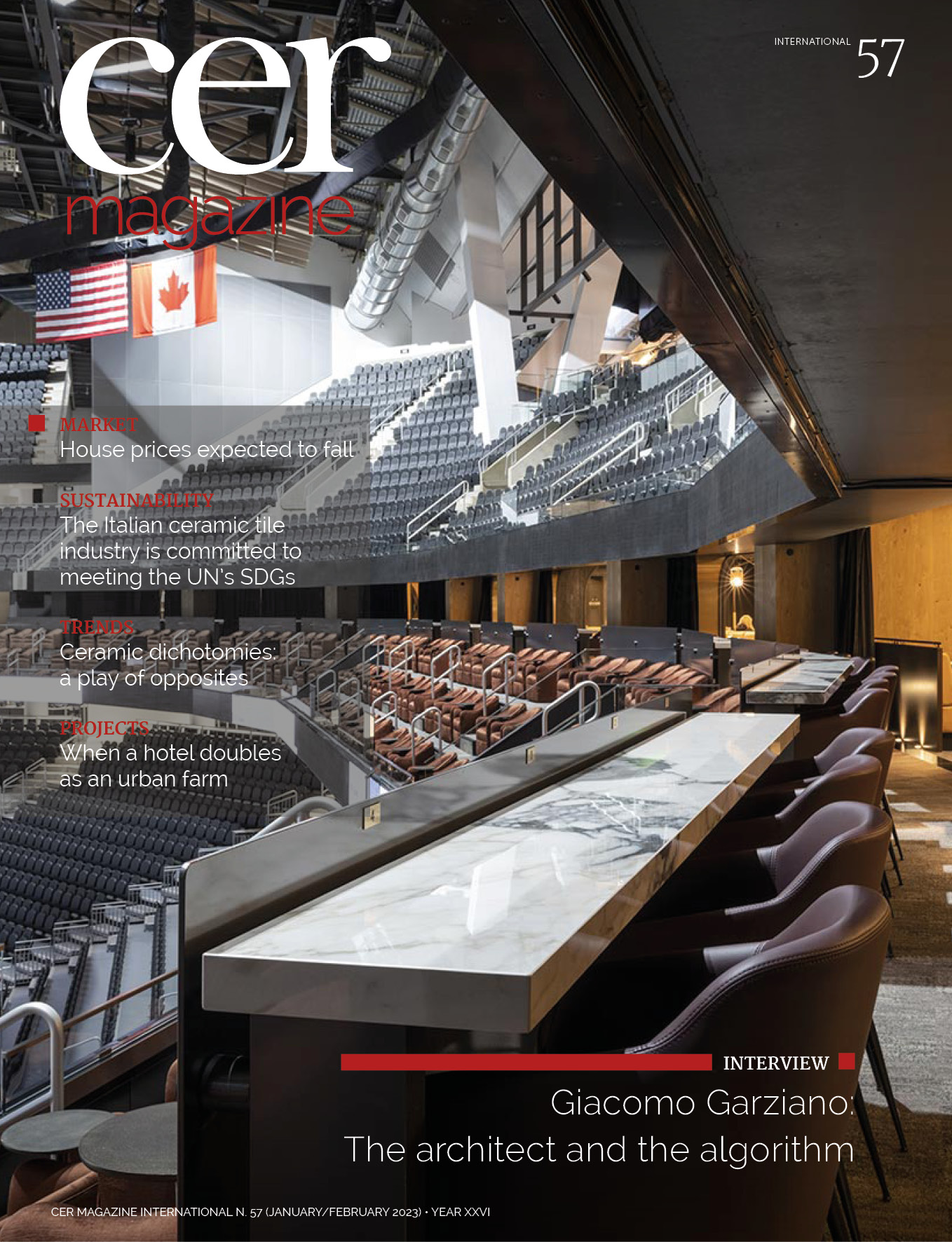Ceramic dichotomies: a play of opposites
The 2022/2023 ceramic tile trends hold up a mirror to our times and reveal a very different world to the one that came before it, a world shaped by the new social behaviours, patterns of consumption and working practices that established themselves during the pandemic. Without doubt, we are living in an age of ceaseless transformation.
As we emerge from a period of severe isolation, our ideas and lifestyles are changing and our real and digital lives have become intertwined in new ways.
Against this unprecedented backdrop, we shall try to predict next year’s trends, which I believe will be closely bound up with the theme of Nature.
Italian tile producers face the challenging task of identifying the needs and expectations of consumers.
According to a survey, 90% of today’s consumers belong to the Boomer, Gen Z, Millennial or Gen X generations. Each generation is different and believes in values that are often the opposite of those of the generations that came before them.
This means that ideas about Nature can be interpreted differently according to the target audience. Trends often run along parallel paths, following almost humoral dichotomies between craftsmanship and technology and in some ways mirroring the process of ongoing transformation that we are all witnessing and adapting to.
The Italian ceramic tile industry is interpreting and responding to all these trends.
Elements
Nature and its elements are key sources of inspiration.
Tiles are not designed to replicate other materials. Instead, it is their colour or pigment that becomes material, creating a sense of craftsmanship and tactility as part of an industrial process.
These soft, earthy colours such as terracotta and red stoneware embody the essential nature of clay.
They have warm, powdery tones, soft and inviting textures ranging from stucco to coloured earth, and a pleasantly soft and silky touch.
The warm colours range from terracotta to magenta (Pantone’s colour of the year, a blend of blue and red that reflects the global zeitgeist and the current period of transition) and periwinkle, blue and green, another on-trend colour.
On the one hand we have natural tones, on the other energising and vibrant colours, cheerful and psychedelic design cues that enable us to finally turn our backs on the dull monotony of lockdown and inject fresh energy into products. While inspired by nature, the colours are saturated and bright, ranging from yellows, reds and oranges through to the blues of water and the sky, while green is another popular shade that coordinates well with all neutral tones.
Contrasts
Another dichotomy can be observed in contrasting combinations of colours or materials. Italian ceramic tiles offer an authentic journey through the world of matter, creating materials that cannot be found in nature or improving others when they are unsuited to our needs.
For any given material, we find harmonious contrasts of colours and finishes, hybridisations that create materials with the appearance of stone, marble or even metal. All of these are blended convincingly, their qualities enhanced by artisanal combinations in an industrial yet utterly contemporary and hi-tech style in keeping with the tastes of the younger generations.
Wood-look ceramic is combined with other formats and materials to create new forms, intermixed to such an extent that it takes on the appearance of a fossil with striking new macro and micro scale geometries.
In its integral version, wood-effect ceramic continues to be highly popular. The range is expanding in leaps and bounds, with ever wider applications and increasingly sophisticated effects. The most contemporary source of inspiration is briarwood and mahogany, materials with maritime and Scandinavian references which are ideal for use on floors and full-height walls and stand out for their glossy, almost mirror-like finishes.
Maximalism
After a year and a half of sobriety, there is a deeply-felt need to stand out from the crowd. So what could be better than the classical elegance of ceramic marble?
Alongside sophisticated white Calacatta and Statuario versions, an entire range of marble-effect ceramic surfaces are now available.
Inspired by classical and exotic marbles, they come in the most original colours ranging from greys to browns, from olive greens to burgundy, from lapis lazuli to golden black, a deep chocolatey colour that contrasts elegantly with the intersecting golden veins. The colours and patterns are new and innovative, the colour combinations surprising, fascinating and unusual, all with a powerful visual impact.
The veining and mirror polished surfaces create soft, flowing effects that are ideally suited to the curved structures of the most fashionable architecture.
Marble-effect ceramic tiles comes in both natural and non-slip versions and can be used both indoors and out, in dry and in wet areas. They are ideal for high-end residential spaces, for the contract, hospitality and hotel sectors, and for luxury applications such as spas, yachts and cruise ships. Stone-look tiles are also making a big comeback as an on-trend material for use in interior design projects. They come in a wide range of versions such as small pebbles, calcareous inclusions, material and mineral textures, reliefs, oxides and botanical impressions formed during the various stages of sedimentation, while the patterns are molecular and micro-grained.
70’s – Patterns
Classical and geometric effects are seeing a revival.
The patterns range from handmade designs with imperfect brushstrokes and a tribal feel to more traditional and classic decorations revisited in a contemporary vein, including fashionable colours. Small geometric patterns and stripes create a sense of orderliness and cleanliness in neutral tones as well as textural, bold colours and rustic, handcrafted textures. The chequerboard motif, a persistent but pleasing repetition of a square geometric shape, is making a major comeback alongside other classical style decorations.
The wide range of Italian ceramic tiles also includes smaller formats, from mosaics to strips and other small sizes that can be readily adapted to curved surfaces.
Supernatural biophilia
Biophilic architecture adopts plant-centred design solutions to strengthen the connection with nature and nurture a sensation of happiness away from the hustle and bustle of everyday life. Bringing nature into our homes and offices creates a feeling of comfort, serenity and relaxation, allowing its calming power to permeate our living spaces.
Ceramic tiles decorate our homes as if they were a carpet, a tapestry or a wallpaper. Natural, floral patterns find their maximum expression on slabs with a single design laid seamlessly side by side. Whether installed horizontally or vertically, they create all-over effects on all surfaces including staircases and are also found in bedrooms, where they are used either to cover the complete wall or to add just a hint of decoration.
Once again, our homes bear witness to the changing times.
Current trends reflect a society that is keen to take care of itself, that is concerned about well-being and sustainability. According to data from the Osservatorio sulla Casa, Italians are showing ever greater interest in eco-sustainable products. And the Italian ceramic industry cares how safe these products are both for the people who make them and for end users.
Alongside interiors, ceramic tiles are increasingly being used in exterior living spaces. Referred to as “outdoor” living, in reality this trend seems more like a joyful, collective invasion of open-air urban areas and relational spaces.
Buildings become multifunctional locations in a state of constant metamorphosis where continuous improvements in the characteristics of ceramic floor and wall tiles enable these materials to be used in entirely new areas such as garages, walkways and gardens, ultimately transforming them into fully-fledged interior and exterior architectural elements.
Spanning craftsmanship and technology, neutral and vibrant colours, natural and artificial material inspirations, glossy and matt effects, interiors and exteriors, the new Italian tile trends once again demonstrate the ability of these products to fulfil any design need in our daily living spaces.
January 2023












































